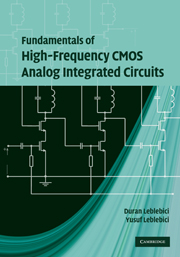Book contents
- Frontmatter
- Contents
- Preface
- 1 Components of analog CMOS ICs
- 2 Basic MOS amplifiers: DC and low-frequency behavior
- 3 High-frequency behavior of basic amplifiers
- 4 Frequency-selective RF circuits
- 5 L-C oscillators
- 6 Analog–digital interface and system-level design considerations
- Appendix A Mobility degradation due to the transversal field
- Appendix B Characteristic curves and parameters of AMS 0.35 micron NMOS and PMOS transistors
- Appendix C BSIM3-v3 parameters of AMS 0.35 micron NMOS and PMOS transistors
- Appendix D Current sources and current mirrors
- References
- Index
5 - L-C oscillators
Published online by Cambridge University Press: 05 June 2012
- Frontmatter
- Contents
- Preface
- 1 Components of analog CMOS ICs
- 2 Basic MOS amplifiers: DC and low-frequency behavior
- 3 High-frequency behavior of basic amplifiers
- 4 Frequency-selective RF circuits
- 5 L-C oscillators
- 6 Analog–digital interface and system-level design considerations
- Appendix A Mobility degradation due to the transversal field
- Appendix B Characteristic curves and parameters of AMS 0.35 micron NMOS and PMOS transistors
- Appendix C BSIM3-v3 parameters of AMS 0.35 micron NMOS and PMOS transistors
- Appendix D Current sources and current mirrors
- References
- Index
Summary
Oscillators, especially sinusoidal oscillators, are among the main components of all RF systems. They are being used as so-called “pilot” oscillators to generate the carrier frequencies of transmitters and as local oscillators in receivers to generate the signals that are necessary for frequency conversion purposes. The most important features of sinusoidal oscillators are the frequency of oscillation and its spectral purity, i.e., the frequency stability and the phase stability. The RF sinusoidal oscillators are almost exclusively based on the resonance effect.
In certain applications it is necessary to adjust the frequency of oscillation in a certain range, or to fine-tune the frequency to a pre-determined value. Since this feature is usually realized by a varactor in the resonance circuit of the oscillator, these circuits are called VCOs (voltage controlled oscillators). In some other applications, the frequency of oscillation must be fixed at a certain frequency with the maximum possible precision and stability. For these cases, quartz crystal oscillators are preferred. If the target frequency is higher than the range supported by the crystal oscillator, a higher frequency VCO can be “locked” to the frequency of the crystal oscillator.
As already explained in Chapter 4, an L-C circuit with external excitation will swing at a frequency determined by the values of its components. The magnitude of the swing decreases in time, owing to the losses of the system.
- Type
- Chapter
- Information
- Fundamentals of High-Frequency CMOS Analog Integrated Circuits , pp. 237 - 258Publisher: Cambridge University PressPrint publication year: 2009



